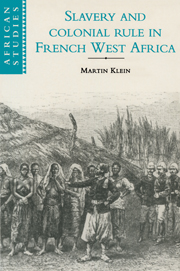Book contents
- Frontmatter
- Contents
- List of illustrations
- List of maps
- List of tables
- Preface
- List of abbreviations
- Glossary
- 1 Slavery in the Western Sudan
- 2 Abolition and retreat. Senegal 1848–1876
- 3 Slavery, slave-trading and social revolution
- 4 Senegal after Brière
- 5 Conquest of the Sudan: Desbordes to Archinard
- 6 Senegal in the 1890s
- 7 The end of the conquest
- 8 The imposition of metropolitan priorities on slavery
- 9 With smoke and mirrors: slavery and the conquest of Guinea
- 10 The Banamba Exodus
- 11 French fears and the limits to an emancipation policy
- 12 Looking for the tracks. How they did it
- 13 After the War: renegotiating social relations
- 14 A question of honor
- Appendixes
- Notes
- Bibliography
- Index
- Titles in the series
10 - The Banamba Exodus
Published online by Cambridge University Press: 07 May 2010
- Frontmatter
- Contents
- List of illustrations
- List of maps
- List of tables
- Preface
- List of abbreviations
- Glossary
- 1 Slavery in the Western Sudan
- 2 Abolition and retreat. Senegal 1848–1876
- 3 Slavery, slave-trading and social revolution
- 4 Senegal after Brière
- 5 Conquest of the Sudan: Desbordes to Archinard
- 6 Senegal in the 1890s
- 7 The end of the conquest
- 8 The imposition of metropolitan priorities on slavery
- 9 With smoke and mirrors: slavery and the conquest of Guinea
- 10 The Banamba Exodus
- 11 French fears and the limits to an emancipation policy
- 12 Looking for the tracks. How they did it
- 13 After the War: renegotiating social relations
- 14 A question of honor
- Appendixes
- Notes
- Bibliography
- Index
- Titles in the series
Summary
Since Logeais has come,
Since Papa Logeais has come,
Since the brother of the little slaves has come,
All men are free.
We no longer cultivate for our masters.
We no longer pound millet for our mistresses.
We can work for ourselves.
We can have children.
Thank you Logeais.
Thank you Papa Logeais.
The children of the slaves will be eternally grateful.
Thanks to you they are men.
Song of Praise to Resident of BanambaIn the spring of 1905, when they were supposed to be preparing for the rains, the slaves of Banamba began to leave their masters. Most were persuaded to remain where they were for one more year, but in the spring of 1906 the exodus began again. For the next four or five years, all across the Sudan, groups of slaves trekked slowly and patiently across the dry savanna lands, braving hunger and deprivation to look for earlier homes. Often villages they sought no longer existed. Sometimes, those enslaved when young had forgotten their clans and even their villages. Many ended up in other places, but hundreds of thousands went home and began the difficult task of reconstructing destroyed communities. The effect of the exodus was the destruction of slavery as a labor system in much of the area covered by this study.
There were already tensions within slave systems, especially within those that most systematically exploited slave labor. Slave flight increased as the period of conquest drew to a close. Population growth in Wasulu and other areas that had been depopulated took place from the moment of French conquest and in spite of risks involved in the return.
- Type
- Chapter
- Information
- Slavery and Colonial Rule in French West Africa , pp. 159 - 177Publisher: Cambridge University PressPrint publication year: 1998

